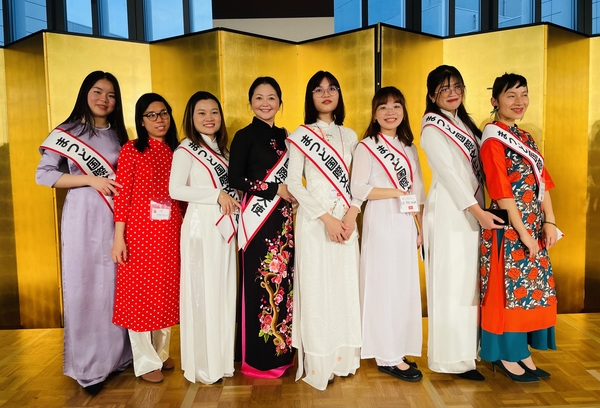Lan, tell us about your cultural experiences! July 2023 Issue
更新日:2023年7月18日
“Ao dai”: Vietnam’s national dress
Have you ever heard the word “ao dai”?
“Ao dai” is the name of Vietnamese traditional costume. In Vietnamese, “ao” means “shirt”, “dai” means “long”, so “ao dai” means “long shirt”.
Comparing to Japanese kimono, “ao dai” is not that expensive (though it depends on the fabric, it’s normally a little more expensive than an one-piece dress). Besides, you can easily wear “ao dai” by yourself so it’s not only used for weddings or special occasions but also for everyday wear, such as high-school uniforms (white “ao dai”) or for hotel receptionists. When mentioning “ao dai”, people often think “ao dai” is worn only by women but there is also men’s ao dai. Most Vietnamese women have at least one “ao dai” in their closet.
One of the features of “ao dai” is emphasizing women’s graceful curves. That’s why Vietnamese women often have made-to-order “ao dai” than ready-to-wear ones. At tailor shops for foreign tourists, “ao dai” can be made in one day after ordering.
If you have a chance to go to Vietnam, please try wearing “ao dai”.

Me and Matsudo Cultural Ambassadors from Vietnam wearing “ao dai”
ベトナム民族衣装「アオザイ」
みなさん、「アオザイ」という言葉を聞いたことがありますか?
「アオザイ」はベトナムの伝統的な民族衣装です。「アオ」はベトナム語で「上着」を、「ザイ」は「長い」を意味していますので、「アオザイ」は「長い上着」のことです。
日本の着物と比べれば、アオザイは値段がそこまで高くないし(生地によりますが、大体ワンピースドレスの値段より少し高い程度)、一人で簡単に着られますので、結婚式やイベントだけではなく、高校の制服(白いアオザイ)やホテルの受付など、普段着としても活用されています。アオザイは女性だけが着用するものと思われがちですが、男性用のものもあります。ベトナム人の女性は大体アイザイを少なくとも一着は持っています。
アオザイの特徴の一つは体の美しいシルエットを出す衣装ですので、市販のものもありますが、オーダーメイドで作ってもらうのが基本です。外国人観光客向けの店であれば、注文してから一日でできあがります。
もし、ベトナムに行く機会があったら是非アオザイを着てみてください。

ベトナム出身のまつど文化大使と一緒に
Click to see the full catalogue of Lan's columns コラムの一覧へ


